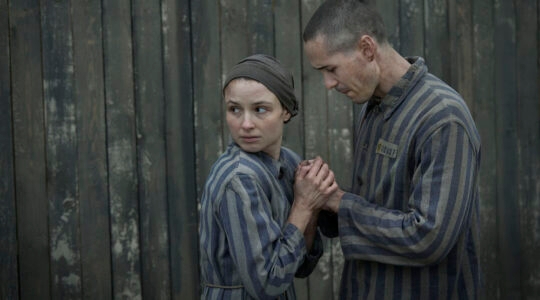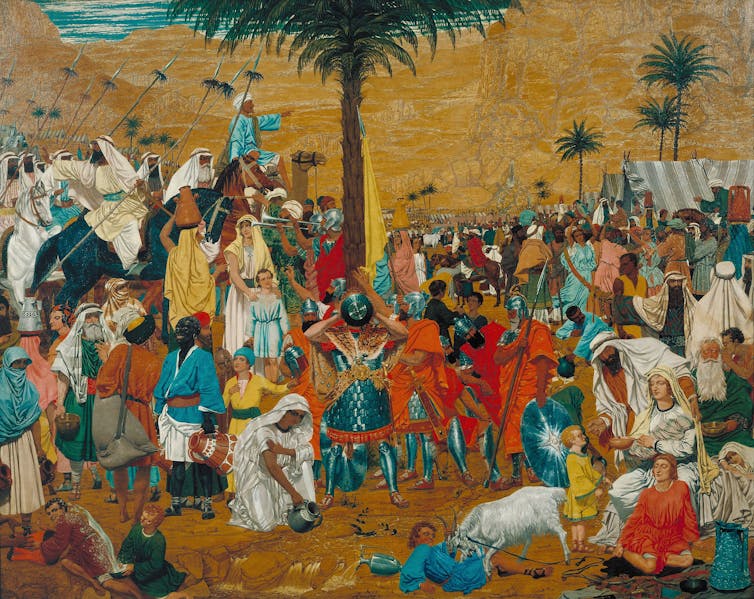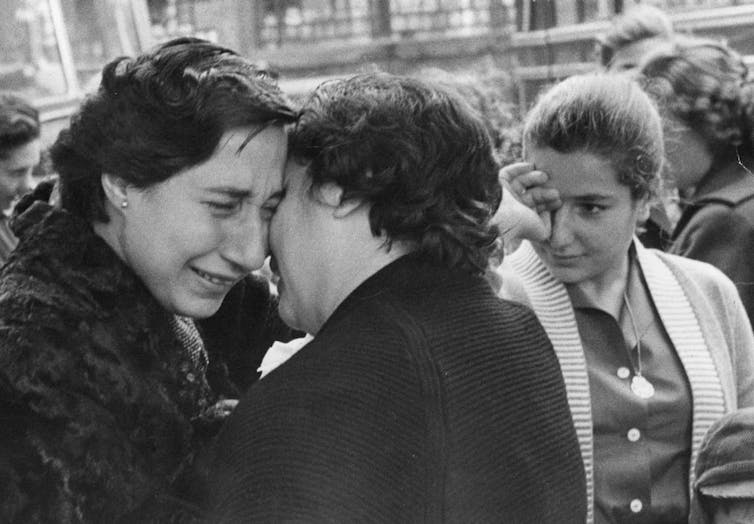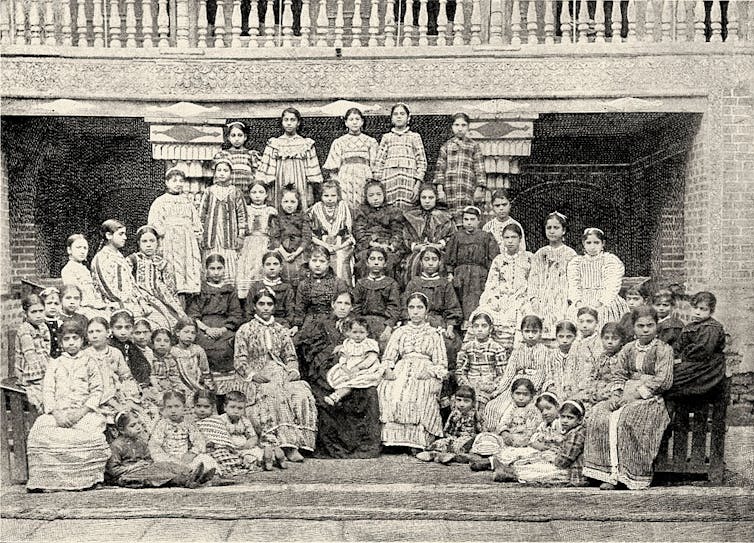
DIGITAL NEWSPAPER
COLLECTIONS

New York Clipper, 2 November 1921 — "WANDERING JEW " IMPRESSIVE AND WELL-ACTED PLAY [ARTICLE]
WANDERING JEW IMPRESSIVE AND WELL-ACTED PLAY
THE WANDERING JEW . a play in four acts and seven scenes , based on the ancient legend of The Wandering Jew , by E . Temple Thurston . Produced at the Knickerbocker Theatre , Wednesday night , October 26 . CAST Judith m ? 1 le 1- SSl ? Rachel . Thais lawton Mathathlas « T , 1 T ? , iSi . £ SKSI Du Gueselln Ka i . Ph Theodore Boemond Robert Some Godtrey Bishop Dickinson Raymond of Toulouse . . Lionel Adams Issacher Howard Lang A page Augustus Anderson Joanne de Beaudricourt Miriam Lewes The Unknown Knlght . Tyrone Power Phirous Melville J . Anderson Mario Charles W . Burrows Andrea Michelottl .... Albert Branlng Matteo Battadio ¦* **_* $ *(_ , ? £ ?** Gianello Battadio . Adele Klaer Pletro MorelU ^ J ^ LASSif AI Kazar Robert Noble Tazzaro Zapportas ... Sidney Herbert Maria Zapportas ... Virginia Russell Arnaldo Zapportas . Augustus Anderson Matteos Battadlos .... Tyrone Power OUalla Qulntana BeUe Bennett Gonzales Ferara ....... Ed ward Kent Alonzo Gastro Howard Boulden Tuan de Texeda Howard Lang Councillor . ™ T Emmet Whitney CounclllOT .:.:.. Charles W . Burrows Officer of the BuiuWtto ^ Dlck , nson Officer of tho Ingulsltlon ^ ^^
As may be inferred from the title , the play is based on the age old myth of the sneering bystander and the Nazarene on the road to Golgotha . It is a production typically English and in a tempo much better suited to their taste than to the speed loving American . However , if the vast audience who flocked steadily to see Hun-Hur will take kindly to the piece then the production will have served its purpose . The progress of the play is divided rather in phases than acts , all of them pompous and pageant like , the text flowing along in pleasing pentameters . In Mr . Thurston s versions of the fable , it takes its start in Jerusalem , on the day of the . crucifixion . After the episode with Christ , Mathias is doomed to wander on the earth until the second coming , and
is seen through the ages in many garbs and colors . He seemed to be having a fair sort of time in most of the places . Tho curtain is lowered to devote the lapse of a thousand years , etc ., and we find the Wandering Jew in the eleventh century outside the gates of Antioch ; two centuries later he is seen in Palermo and later at Seville during thc Spanish Inquisition . Here a great hour is reached as the Jew is before the tribunal and is tried for heresy , which is a brilliant and moving scene . The high point is reached as the old Jew , wise , inscrutable and unafraid , is stirred by the sight of the elegant judges and their bcjeweled cross to a mystical reminiscence of an afternoon 1 , 500 years before and another rough hewn cross that he has seen borne up the slope of Calvary . This scene , simply played by Tyrone Powers , held the audience still enough to hear thc drop of a
Mr . Powers was splendid all through the play , for the part was well suited to thc actor of the old school . All of the cast acquitted themselves in good style . The show was richly staged and David Belasco and A . L . Erlanger arc credited with the production . It may not appeal to those who seek only the frivolous in plays , but will provide good cntcrtaiifment for those who care for the more quiet and worth while p lays . Though it is of the slow moving order , it is doubtful whether any criticism could suggest a better way of handling any of the situations or any other part . . On the whole it was quite perfectly produced and acted .
Terms of use
Content statement.

The Wandering Jew Broadway Original Cast

The Wandering Jew FREQUENTLY ASKED QUESTIONS
The Wandering Jew has had 2 productions including Broadway which opened in 1921 and Broadway which opened in 1927.

TICKET CENTRAL
.jpg)
Recommended For You

- Medium FontSize
- Larger FontSize
- Largest FontSize
- Image Gallery
- Home
- About the Catalogue
- Search the Catalogue
- Search by Person
- Search by Production
- Search by Role
- How to Search
- Useful Links
- Contact Us
- © National Theatre
- Privacy Policy
The Wandering Jew
The film is based on Temple Thurston's play of the same name, and the adaptation is divided into four episodes. The first is Jerusalem on the day of the Crucifixion; the second, Antioch in the time of the first crusade; third, Palermo, Sicily, in 1290; and fourth, Seville in 1560, during the Inquisition.
By Variety Staff
Variety Staff
Follow Us on Twitter
- Variety Racks Up Over 138 Million Views in Record-Breaking 2024 Oscars Social Video Traffic 2 months ago
- Variety Promotes Rachel Seo to Social Media Editor 2 months ago
- Super Bowl LVIII: The Best Merch, Collectibles and Accessories to Celebrate the Big Game 3 months ago
The film is based on Temple Thurston’s play of the same name, and the adaptation is divided into four episodes. The first is Jerusalem on the day of the Crucifixion; the second, Antioch in the time of the first crusade; third, Palermo, Sicily, in 1290; and fourth, Seville in 1560, during the Inquisition.
It is a massive, artistic and well-acted filming, flavored perhaps by an overplus of scenes, and more detail than is necessary.
Conrad Veidt in the first half of the picture is guilty of scene-chewing. All this is counteracted before the finish by a restrained, moving dignity which he contributes to the wanderer of centuries.
Maria Ney, Anne Grey and Joan Maude are the three women in the first three episodes, and do nothing to distinguish themselves; Peggy Ashcroft as the Magdalene in the fourth phase, who is converted by the Christ-like nobility of Battadios (Veidt), offers a fine characterization rich in feeling. The inquisitors are Francis L. Sullivan, Felix Aylmer and Ivor Barnard, all of them vividly Machiavellian.
- Production: Twickenham/Gaumont-British. Director Maurice Elvey; Producer Julius Hagen; Screenplay H. Fowler Mear; Camera Sydney Blythe; Editor Jack Harris; Art Director James Carter
- Crew: (B&W) Extract of a review from 1933. Running time: 110 MIN.
- With: Conrad Veidt Marie Ney Anne Grey Joan Maude Peggy Ashcroft
More From Our Brands
President biden and netanyahu discuss cease-fire deal, humanitarian aid, aston martin’s fastest-ever vantage makes formula 1® debut, mlbpa rips nike amid changes to controversial uniforms, be tough on dirt but gentle on your body with the best soaps for sensitive skin, the conners is losing its wednesdays-at-8 time slot on abc — find out why, verify it's you, please log in.
Get JTA's Daily Briefing in your inbox
I accept the JTA Privacy Policy .
By submitting the above I agree to the privacy policy and terms of use of JTA.org
Why this Houseplant is Called the Wandering Jew
Have you watered your Wandering Jew? As you may know, the popular spiderwort ( tradescantia ) is a convenient and flexible houseplant—it can be planted in soil or set to hang in a pot, and it’s very patient with forgetful owners . Its name calls to mind Moses and the Israelites in the Sinai Desert, wandering for 40 years.
But the plant’s name actually refers to a more recent, and sinister, legend of a Jew who scoffed at Jesus en route to his crucifixion. The story isn’t actually canonical —the earliest versions appeared in the 13th century , and were popularizied in the 17th century in by a pamphleteer named Ahashver. (Interestingly, this name is derived from Ahasuerus, the Persian king of the Purim story .)
This motif of the wandering Jew also took form as an 1844 French novel , opera, and silent film which weren’t anti-Semitic so much as straight-up depressing: A Jewish man is separated from his sister by the Bering Strait and condemned to wander the Earth forever. A plague of cholera follows in his wake, and—spoiler alert—he never finds his sister.
Pretty heavy legacy for a houseplant.
__ Watch the silent film, The Wandering Jew :
Recommended from JTA

Seeking out sites from the bygone Borscht Belt? New historical markers lay out a path.

These young adult novels are expanding the way literature depicts Jewish teens

Generations of immigrants to the Lower East Side are celebrated in a new picture book

A fifth question this Passover: Why does that Manischewitz matzah box look so different?

Peacock’s ‘The Tattooist of Auschwitz’ tackles a Holocaust love story based on real events

New stand-up shows aim to revive the Borscht Belt’s Jewish comedy legacy

Download the free Kindle app and start reading Kindle books instantly on your smartphone, tablet, or computer - no Kindle device required .
Read instantly on your browser with Kindle for Web.
Using your mobile phone camera - scan the code below and download the Kindle app.

Image Unavailable

- To view this video download Flash Player
The Wandering Jew; a Play in Four Phases Hardcover – August 27, 2016
This work has been selected by scholars as being culturally important, and is part of the knowledge base of civilization as we know it. This work was reproduced from the original artifact, and remains as true to the original work as possible. Therefore, you will see the original copyright references, library stamps (as most of these works have been housed in our most important libraries around the world), and other notations in the work.
This work is in the public domain in the United States of America, and possibly other nations. Within the United States, you may freely copy and distribute this work, as no entity (individual or corporate) has a copyright on the body of the work.
As a reproduction of a historical artifact, this work may contain missing or blurred pages, poor pictures, errant marks, etc. Scholars believe, and we concur, that this work is important enough to be preserved, reproduced, and made generally available to the public. We appreciate your support of the preservation process, and thank you for being an important part of keeping this knowledge alive and relevant.
- Print length 178 pages
- Language English
- Publisher Wentworth Press
- Publication date August 27, 2016
- Dimensions 6.14 x 0.44 x 9.21 inches
- ISBN-10 1371754209
- ISBN-13 978-1371754204
- See all details

Product details
- Publisher : Wentworth Press (August 27, 2016)
- Language : English
- Hardcover : 178 pages
- ISBN-10 : 1371754209
- ISBN-13 : 978-1371754204
- Item Weight : 15 ounces
- Dimensions : 6.14 x 0.44 x 9.21 inches
Customer reviews
Customer Reviews, including Product Star Ratings help customers to learn more about the product and decide whether it is the right product for them.
To calculate the overall star rating and percentage breakdown by star, we don’t use a simple average. Instead, our system considers things like how recent a review is and if the reviewer bought the item on Amazon. It also analyzed reviews to verify trustworthiness.

No customer reviews
- Amazon Newsletter
- About Amazon
- Accessibility
- Sustainability
- Press Center
- Investor Relations
- Amazon Devices
- Amazon Science
- Sell on Amazon
- Sell apps on Amazon
- Supply to Amazon
- Protect & Build Your Brand
- Become an Affiliate
- Become a Delivery Driver
- Start a Package Delivery Business
- Advertise Your Products
- Self-Publish with Us
- Become an Amazon Hub Partner
- › See More Ways to Make Money
- Amazon Visa
- Amazon Store Card
- Amazon Secured Card
- Amazon Business Card
- Shop with Points
- Credit Card Marketplace
- Reload Your Balance
- Amazon Currency Converter
- Your Account
- Your Orders
- Shipping Rates & Policies
- Amazon Prime
- Returns & Replacements
- Manage Your Content and Devices
- Recalls and Product Safety Alerts
- Conditions of Use
- Privacy Notice
- Consumer Health Data Privacy Disclosure
- Your Ads Privacy Choices
Log in or sign up for Rotten Tomatoes
Trouble logging in?
By continuing, you agree to the Privacy Policy and the Terms and Policies , and to receive email from the Fandango Media Brands .
By creating an account, you agree to the Privacy Policy and the Terms and Policies , and to receive email from Rotten Tomatoes and to receive email from the Fandango Media Brands .
By creating an account, you agree to the Privacy Policy and the Terms and Policies , and to receive email from Rotten Tomatoes.
Email not verified
Let's keep in touch.

Sign up for the Rotten Tomatoes newsletter to get weekly updates on:
- Upcoming Movies and TV shows
- Trivia & Rotten Tomatoes Podcast
- Media News + More
By clicking "Sign Me Up," you are agreeing to receive occasional emails and communications from Fandango Media (Fandango, Vudu, and Rotten Tomatoes) and consenting to Fandango's Privacy Policy and Terms and Policies . Please allow 10 business days for your account to reflect your preferences.
OK, got it!
Movies / TV
No results found.
- What's the Tomatometer®?
- Login/signup
Movies in theaters
- Opening this week
- Top box office
- Coming soon to theaters
- Certified fresh movies
Movies at home
- Fandango at Home
- Netflix streaming
- Prime Video
- Most popular streaming movies
- What to Watch New
Certified fresh picks
- Challengers Link to Challengers
- I Saw the TV Glow Link to I Saw the TV Glow
- Música Link to Música
New TV Tonight
- The Veil: Season 1
- Hacks: Season 3
- The Tattooist of Auschwitz: Season 1
- A Man in Full: Season 1
- Acapulco: Season 3
- Welcome to Wrexham: Season 3
- John Mulaney Presents: Everybody's in LA: Season 1
- Star Wars: Tales of the Empire: Season 1
- My Next Guest Needs No Introduction With David Letterman: Season 4.2
- Shardlake: Season 1
Most Popular TV on RT
- Baby Reindeer: Season 1
- Fallout: Season 1
- Shōgun: Season 1
- Dead Boy Detectives: Season 1
- Velma: Season 2
- Them: Season 2
- Ripley: Season 1
- Under the Bridge: Season 1
- 3 Body Problem: Season 1
- We Were the Lucky Ones: Season 1
- Best TV Shows
- Most Popular TV
- TV & Streaming News
Certified fresh pick
- Dead Boy Detectives: Season 1 Link to Dead Boy Detectives: Season 1
- All-Time Lists
- Binge Guide
- Comics on TV
- Five Favorite Films
- Video Interviews
- Weekend Box Office
- Weekly Ketchup
- What to Watch
All Zendaya Movies Ranked by Tomatometer
Video Game TV Shows Ranked by Tomatometer
What to Watch: In Theaters and On Streaming
Awards Tour
The Most Anticipated Movies of 2024
Poll: Most Anticipated Movies of May 2024
- Trending on RT
- Most Anticipated TV of May
- Seen on Screen
- Zendaya Movies
- Play Movie Trivia
The Wandering Jew
Audience reviews, cast & crew.
Maurice Elvey
Matheson Lang
Malvina Longfellow
Isobel Elsom
Olalla Quintane
Shayle Gardner
Pietro Morelli
Hector Abbas
More Like This
- ADMIN AREA MY BOOKSHELF MY DASHBOARD MY PROFILE SIGN OUT SIGN IN
Recovering from the creative slump of Collin and Five Days in June, Heym is again recognizable as the vibrant author of...
READ REVIEW
THE WANDERING JEW
by Stefan Heym ‧ RELEASE DATE: Jan. 1, 1983
Recovering from the creative slump of Collin and Five Days in June, Heym is again recognizable as the vibrant author of Hostages and The King David Report--in this startling, bold, half-successful historical/theological novel. ""We are falling,"" the book begins: the ""we"" are angels, Lucifer included, cast out of Heaven soon after Creation. And one of these fallen angels is Ahasverus, who continues thereafter to show up in history as the Wandering Jew--ordered by Jesus to exist forever, to serve as a reminder of those who rejected Christ's divinity. An East German scholar is uncomfortably made aware of the Jew's reappearance as a shoemaker in contemporary Jerusalem; and four hundred years earlier, a Reformation-era German pastor, Paulus von Eitzen, finds the Jew (in yet some other guise) tormenting him, which leads to a vile, virulent, but apparently routine church campaign of anti-Semitism, Heym isn't subtle here: this is a very head-on indictment of Christianity's problems with the Jews, suggesting that Christianity may be inherently incapable of bringing about peace and justice; instead, murder and oppression are fomented. Also, by chopping tho allegory into such disparate time-zones, the book palls under an air of schema, rigidity, set-up. But many of the scenes are electric with imaginative courage--especially an apocalyptic reunion between Rabbi Joshua (Jesus) and God. (In a father-son confrontation of disappointment and revulsion, they discover that they have no use for each other.) And though too stiff and disjointed to provide steady narrative interest, this is fiery, passionate, mordantly discomforting work.
Pub Date: Jan. 1, 1983
Page Count: -
Publisher: Holt, Rinehart & Winston
Review Posted Online: N/A
Kirkus Reviews Issue: Jan. 1, 1983
Categories: FICTION
- Discover Books Fiction Thriller & Suspense Mystery & Detective Romance Science Fiction & Fantasy Nonfiction Biography & Memoir Teens & Young Adult Children's
- News & Features Bestsellers Book Lists Profiles Perspectives Awards Seen & Heard Book to Screen Kirkus TV videos In the News
- Kirkus Prize Winners & Finalists About the Kirkus Prize Kirkus Prize Judges
- Magazine Current Issue All Issues Manage My Subscription Subscribe
- Writers’ Center Hire a Professional Book Editor Get Your Book Reviewed Advertise Your Book Launch a Pro Connect Author Page Learn About The Book Industry
- More Kirkus Diversity Collections Kirkus Pro Connect My Account/Login
- About Kirkus History Our Team Contest FAQ Press Center Info For Publishers
- Privacy Policy
- Terms & Conditions
- Reprints, Permission & Excerpting Policy
© Copyright 2024 Kirkus Media LLC. All Rights Reserved.
Popular in this Genre
Hey there, book lover.
We’re glad you found a book that interests you!
Please select an existing bookshelf
Create a new bookshelf.
We can’t wait for you to join Kirkus!
Please sign up to continue.
It’s free and takes less than 10 seconds!
Already have an account? Log in.
Trouble signing in? Retrieve credentials.
Almost there!
- Industry Professional
Welcome Back!
Passover: The festival of freedom and the ambivalence of exile
Professor of Comparative Literature, Arts & Sciences at Washington University in St. Louis
Disclosure statement
Nancy E. Berg does not work for, consult, own shares in or receive funding from any company or organisation that would benefit from this article, and has disclosed no relevant affiliations beyond their academic appointment.
Arts & Sciences at Washington University in St. Louis provides funding as a member of The Conversation US.
View all partners
The Jewish holiday cycle is, to a large extent, an exploration and commemoration of the experience of exile. The fall festival of Sukkot , for example, is celebrated in small booths, temporary shelters that recall the Israelites’ experience sheltering in tents while wandering in the desert for 40 years after fleeing slavery in Egypt. The story of Purim, a springtime festival , takes place when ancient Jews lived in exile in the Persian Empire – and illustrates the precariousness of life as a minority.
And then there’s Passover, which begins on April 22, 2024. It marks the Israelites’ Exodus from Egypt – the first step toward redemption. The theme of freedom dominates the holiday.
Passover is the only holiday that marks the transition from exile to wandering, and not to homecoming, highlighting the complexity of exile – the focus of my recently published book , “Exile and the Jews,” co-edited with Marc Saperstein .
As a literary scholar , I look to novels and memoirs for examples that illustrate exile and its aftermath from different perspectives. Here I focus on those from the Jewish communities of Egypt and Iraq, sites of the two major exiles in Jewish history.
Into the unknown
In her 1983 novella “ The Miracle Hater ,” the late Israeli novelist Shulamit Hareven depicts the Hebrews in their passage from Egypt and their first taste of freedom. Writing a modern “midrash” – a rabbinic genre that elaborates on a biblical text – she reimagines the story of Exodus .
Whereas the biblical description centers on heroic leaders like Moses and Joshua, Hareven concentrates on the unnamed masses: the Jewish slaves who have just crossed the Red Sea, now faced with life in the desert and becoming a new community.

Hareven’s narrative elaborates on the uprooting wrought by the Exodus, exploring the unexpected ambivalence with which the Hebrews face their newfound freedom. They have fled oppression, but that means leaving everything familiar to wander, seemingly endlessly, in the great unknown of the desert.
Israeli writer Orly Castel-Bloom weaves family lore, history and some alternative history into “ An Egyptian Novel ,” published in 2015. She both invents and lays claim to the one family who did not join the exodus in ancient times but remained in Egypt throughout the ages. Although they are merely a passing mention, their existence gives the reader pause to wonder if indeed any of the Hebrews stayed behind.
Many Jews did stay behind after the next major exile in Jewish history, which began when Babylonia besieged Jerusalem and deported residents of the conquered city in 586 B.C.E. When Persian king Cyrus the Great issued an edict almost 50 years later inviting the Jews to return to Jerusalem and the land of Judah, only a minority did so. Those who remained in Babylon became the root of the diaspora and established the oldest continuous Jewish community in the world.
‘Out of Egypt’
More recently, Jews have lived in both of these sites of ancient exiles: modern-day Egypt and Iraq. While those in Iraq could claim a history of hundreds of years , those in Egypt were more likely to have moved there within the last few generations.
In his 1995 memoir “Out of Egypt ,” novelist, essayist and professor André Aciman – best known for the book-turned-film “Call Me By My Name” – writes movingly and memorably about living on the eve of exile.
By the early 1960s, Jews found themselves less welcome in Egypt . Aciman details the harassment his family endured – anonymous phone calls, surveillance, seizure of the family business by the government – before they were given orders to leave .
“It never occurred to us that a seder in Egypt was a contradiction in terms,” he wrote in The New York Times , describing the Passover meal his family held the night before their departure. The Egypt of the Exodus story seemed far from the Egypt of Aciman’s childhood, the one he loved.

Looking back at that last meal, the novelist wondered just what was being celebrated , and which departure of the Jews the Seder was commemorating. “The fault lines of exile and diaspora always run deep, and we are always from elsewhere, and from elsewhere before that,” he noted.
In “ Out of Egypt ,” the irony of the family preparing to leave on Passover is not lost on the author, the reader or, one suspects, the characters themselves. After a rather dismal attempt at a Seder, the narrator wandered through the streets of Alexandria, mourning a place that had become home. Until this moment, the idea of Egypt as a place of exile had not occurred to him; the idea of Israel being a place of return foreign.
On that last evening, the narrator walked the promenade along the waterfront and was offered “fiteer,” sold on street corners in honor of the Muslim holiday of Ramadan. It is not kosher for Passover, when leavened grains are forbidden, but the boy enjoyed the fried dough, the taste of which he recalled with pleasure many years later.
The blend of cultures, foreign and local, shows the family to be not unlike other cosmopolitan-mongrel Jews living in Egypt at the time. The city was “so inseparable from who I was at that very instant,” the narrator recalls. “And suddenly I knew … that I would always remember this night.”

It is a poignant account of the very personal nature of exile. And yet it is an experience potentially shared by everyone in the Jewish community. Exile is a place unknown, over the edge of the precipice.
The Passover holiday is also at the center of British journalist Tim Judah’s visit to Iraq to cover the 2003 American invasion. He was the first of his family in many years to “return” to Baghdad. His father’s family had left Iraq in the 19th century for India in the wake of persecutions during Dawud Pasha’s reign.
Noting that his visit would coincide with the holiday, Judah set out to meet as many of the estimated three dozen Jews who still lived in Iraq. The journalist found faint traces of the once-thriving community: palimpsests of stars of David in brickwork, a Hebrew inscription in Ezekiel’s tomb. At the time of Iraq’s independence in 1932, Jews comprised a plurality in the capital; business came to a standstill on Saturdays, the Jewish Sabbath.

The rise of Arab nationalism , the establishment of the state of Israel and shifting geopolitics led to the mass emigration of the Jewish community in the early 1950s. By 2003, the few Jews Judah found lived in trepidation and ramshackle homes.
“I tried to picture my forebears, in the fields or perhaps in the shops or the market, but I couldn’t,” Judah wrote in Granta magazine . “A cold grey dust filled the air. Wrecked cars and burnt-out tanks littered the road back to Baghdad. … So my ancestors lived here for 2,500 years? So what? My pilgrimage was over. I will never need to do it again.”
Judah’s pilgrimage leads not to a renewed sense of belonging but a break. His family’s uprooting is complete.
And so it goes, the cycle of exile and remembrance, uprooting and rerooting. With the Passover holiday, those free can celebrate their freedom, and those who are rooted, their rootedness. Yet at the same time, families around the Seder table can remember those who are not yet free, and those still suffering from being uprooted.
- Jewish exile
- Religion and society

Executive Dean, Faculty of Health

Associate Lecturer - Medical Education (Professional Practice)

Lecturer/Senior Lecturer, Earth System Science (School of Science)

Sydney Horizon Educators (Identified)

Deputy Social Media Producer
Advertisement
Supported by
College Protests Over Gaza Deepen Democratic Rifts
Scenes of chaos unfolding on campuses across the country are stoking internal divisions and carry political risk as a major election year unfolds.
- Share full article

By Katie Glueck
Nearly seven months after the Israel-Hamas war began, the demonstrations convulsing college campuses nationwide are exposing fresh tensions within the Democratic Party over how to balance free speech protections and support for Gazans with concerns that some Jewish Americans are raising about antisemitism .
From New York and Los Angeles to Atlanta and Austin, a surge in student activism has manifested in protest encampments and other demonstrations, drawing significant police crackdowns and sometimes appearing to attract outside agitators. The protests also have emerged as the latest flashpoint in the internal Democratic debate over the war.
As scenes of campus turmoil play out across the country in the final days of the school year , the moment also carries political risk for a party that has harnessed promises of stability and normalcy to win critical recent elections, and faces a challenging battle for control of the government in the fall.
“The real question is, can the Democrats again portray themselves as the steady hand at the helm?” said Dan Sena, a veteran Democratic strategist. “Things that create national chaos like this make that harder to do.”
Mr. Sena and other Democrats have argued that Americans have good reason to associate their opponents with chaos: Former President Donald J. Trump faces multiple criminal cases ; the narrow, fractious House Republican majority has its own divisions concerning Israel and free speech; some Republicans have urged National Guard deployments to college campuses; and for years, Republicans have faced criticism over antisemitism in their own ranks .
But since the Hamas-led attack on Israel on Oct. 7, and the Israeli military response that has killed more than 30,000 people, according to local authorities, the fight over American policy toward Israel has been especially pronounced on the left .
Most Democrats say they both support free speech and condemn antisemitism, and consider criticism of the Israeli government to be fair game. But in seeking to address an intractable conflict marked by competing historical narratives, debates over how to distinguish between legitimate criticism of Israel and antisemitic speech are fraught and reaching a fever pitch on campus.
To some lawmakers who have visited encampments and attended demonstrations, the students are part of a long tradition of campus activism, and their free speech rights are at risk. Incidents of antisemitism, they say, do not reflect a broader movement that includes many young progressive Jews.
Representative Greg Casar of Texas went to the University of Texas to show solidarity with demonstrators, linking their activism to that of students who opposed the Vietnam and Iraq wars.
“So often, history ends up vindicating those who call for peace early,” he said. “I do think that more and more members of Congress will start to show up at these events and start to hear out more and more of where the students are coming from.”
Asked about instances in which demonstrators around the country have used antisemitic language, Mr. Casar replied, “those people suck.”
“They’re not a part of the peace movement,” he said. “Anybody that’s motivated by hatred — be it racism, Islamophobia, antisemitism, hatred of any form — they’re not peaceful.”
But to other Democrats, instances of intimidation and harassment described by some Jewish students are a defining feature of the campus movement.
Nowhere have those tensions been more clear than at Columbia University, which has become both an epicenter of the protest movement and a focal point for its detractors.
Democrats including President Biden , House and Senate leaders and prominent Senate candidates such as Representatives Adam Schiff in California and Ruben Gallego in Arizona have condemned antisemitic harassment around Columbia.
Other Democrats have sought to show solidarity in person with Jewish students who have described feeling unsafe. Representative Jared Moskowitz, a Florida Democrat, recently visited the campus with several other Jewish lawmakers.
Some in his party, he said, were downplaying the hard-line nature of some of the demonstrations.
“There are people who are peaceful, and there are not,” he said. “But there’s a denial from my friends on the left,” a view that “‘everyone’s peaceful, there’s no antisemitism.’”
He declined to name names, though he and Representative Alexandria Ocasio-Cortez have sparred on social media . Ms. Ocasio-Cortez of New York, one of several progressive lawmakers who have visited the Columbia encampment, has also condemned “horrific people wandering outside” Columbia’s campus who espouse “virulent antisemitism.”
But broadly, Mr. Moskowitz argued, some on the left who rightfully criticized antisemitic chants from “white, Aryan-looking men with tiki torches” rallying in Charlottesville, Va., in 2017 seemed reluctant to denounce threatening speech when it came from liberal-leaning Americans.
“I don’t see the same level of outrage,” Mr. Moskowitz said. “It’s politically inconvenient now.”
Representative Jerrold Nadler of New York, a long-serving Jewish member of Congress, has also expressed concerns about antisemitism. But he said his party was consistent in calling out bigotry, in contrast to many Republicans, pointing to Charlottesville. (Mr. Moskowitz shared that assessment about Republicans.)
“Democrats are willing to call out antisemitism, wherever it is, and certainly there’s been some antisemitism on campuses,” Mr. Nadler said, though he questioned how representative the demonstrations were of the student body.
Lauren Hitt, a spokeswoman for Mr. Biden’s campaign, said that “while Donald Trump stood proudly with white supremacists and encouraged violent crackdowns on peaceful demonstrators,” Mr. Biden defends the First Amendment and has “strengthened protections against antisemitism and Islamophobia.”
In Georgia, where demonstrators at Emory University were subdued forcefully , State Representative Ruwa Romman said that “there is no room for antisemitism in this movement.”
But she warned against focusing on a “few agitators” over the “thousands of students who are welcoming, who believe in a multiracial, multicultural, multi-faith world.”
“When we lose young people, we’re not just losing at the ballot box,” said Ms. Romman, a Democrat who is Palestinian. “We’re losing them in the entire electoral apparatus.”
In the meantime, some Republicans are seeking to paint the whole Democratic Party as extreme and overly attuned to concerns of Ivy League protesters.
Democrats “are demonstrating that they’re listening to a very small, very radical, very online segment of their base that is not representative of the broader electorate,” said Jack Pandol, a spokesman for the House Republican campaign arm, which is selling T-shirts that allude to a profanity aimed at Hamas.
Former Representative Steve Israel, who led the House Democratic campaign arm, said that while Republicans might see a messaging opportunity, it was far too early to determine whether it would be potent come November.
“Campuses generally clear out in summer, the energy on this issue may dissipate and the question will be whether it returns in the fall,” he said. “The answer to that isn’t here. It’s in the Middle East.”
Katie Glueck covers American politics with a focus on the Democratic Party. More about Katie Glueck

IMAGES
VIDEO
COMMENTS
In the play Genboerne ( The Residents) by Jens Christian Hostrup (1844), the Wandering Jew is a character (in this context called "Jerusalem's shoemaker") and his shoes make the wearer invisible. The protagonist of the play borrows the shoes for a night and visits the house across the street as an invisible man.
WANDERING JEW IMPRESSIVE AND WELL-ACTED PLAY. THE WANDERING JEW . a play in four acts and seven scenes , based on the ancient legend of The Wandering Jew , by E . Temple Thurston . ... Tho curtain is lowered to devote the lapse of a thousand years , etc ., and we find the Wandering Jew in the eleventh century outside the gates of Antioch ; two ...
The play begins with the Librarian appearing on stage, which is sparsely furnished with a whiteboard and marker pens, a magnetic bulletin board, and a table. ... Eventually, the audience learns that the person to whom all of the Librarian's items relate may be Ahasuerus the Wandering Jew, a mythical figure from medieval Christian folklore.
Opening Date. Oct 26 1921. Closing Date. Dec 1 1921. Performances. 69 as of Apr 01, 2024. Playbill Pro The Wandering Jew. The Wandering Jew.
His best-known work for the stage is The Wandering Jew, a play based on the legend written in four parts, which was performed on Broadway in 1921. The play was adapted for a silent film of the same name in 1923, and a sound remake was released in 1933. His third wife, Emily, published the play as a novel in 1934.
The Wandering Jew has had 2 productions including Broadway which opened in 1921 and Broadway which opened in 1927. Videos. First Look at FIDDLER ON THE ROOF at Paper Mill Playhouse.
The Wandering Jew: Author: Wandor, Michelene: Author Two: Alfreds, Mike: Author Three: Sue, Eugene (from novel by) Venue: Lyttelton Theatre, National Theatre: ... Premiere of epic play 'The Wandering Jew' to open in summer: 6 May 1987: Press Releases 1980-1989: RNT/PP/3/9/3/55: The Wandering Jew: 1987: Lyttelton Cast Lists
appearing as the "Wanderer" in Siegfried; Parsifal, wandering in search of the Grail during the Prelude to Act III of the opera; Kundry, repre-senting a female version of the Wandering Jew; and Tristan, fleeing Cornwill after his disloyalty to Mark is discovered. Reflecting on the title of his only published play, Joyce wrote, "Exiles--also ...
The Wandering Jew, illustration by Gustave Doré, 1856. wandering Jew, in Christian legend, character doomed to live until the end of the world because he taunted Jesus on the way to the Crucifixion. A reference in John 18:20-22 to an officer who struck Jesus at his arraignment before Annas is sometimes cited as the basis for the legend.
The Wandering Jew: A Play in Four Phases. Ernest Temple Thurston. G.P. Putnam's Sons, 1921 - English drama - 156 pages . Preview this book ...
The Wandering Jew: A Play in Four Phases. Ernest Temple Thurston. G.P. Putnam's Sons, 1920 - Wandering Jew - 156 pages . Preview this book ...
The Wandering Jew in the Twenty-First Century • 197 Wandering Jew legend, the life of Christ. Perry innovates by focusing not on the Passion, but on the resurrection. Her Melmoth was present when Jesus emerged from his tomb; she is cursed for being afraid to share her witness. Each of these contemporary novels uses the Wandering Jew as an instru-
The Wandering Jew, A Play In Four Phases. Read more Report an issue with this product or seller. Previous page. Language. English. Publisher. G.P.Putnam's Sons. Publication date. January 1, 1920. See all details. Next page. The Amazon Book Review Book recommendations, author interviews, editors' picks, and more.
The Wandering Jew The film is based on Temple Thurston's play of the same name, and the adaptation is divided into four episodes. The first is Jerusalem on the day of the Crucifixion; the second ...
This motif of the wandering Jew also took form as an 1844 French novel, opera, and silent film which weren't anti-Semitic so much as straight-up depressing: A Jewish man is separated from his ...
The Wandering Jew; a Play in Four Phases [Thurston, E. Temple (Ernest Temple) 187] on Amazon.com. *FREE* shipping on qualifying offers. The Wandering Jew; a Play in Four Phases
Publication [ edit] The Wandering Jew was a serially published novel, which attained great popularity in Paris, and beyond. According to historian John McGreevy, the novel was intensely and deliberately "anti-Catholic". [2] Its publication, and that of its predecessor The Mysteries of Paris, greatly increased the circulation of the magazines in ...
The Wandering Jew 1923 1 hr. 25 min. Drama List Reviews Cursed with eternal life for demanding that Christ be crucified, a Jew (Matheson Lang) roams the world for 13 centuries.
Published in Nature. Philosophy. THIS last volume of Mr. Conway's is a study, not only of the legend of the Wandering Jew, but with it of the large group of analogous myths of undying men who from age to age wander over the earth, or sleep in caverns, or are translated from among men into divine regions, whence however they come back and show ...
Recovering from the creative slump of Collin and Five Days in June, Heym is again recognizable as the vibrant author of Hostages and The King David Report--in this startling, bold, half-successful historical/theological novel. ""We are falling,"" the book begins: the ""we"" are angels, Lucifer included, cast out of Heaven soon after Creation.
The Wandering Jew's Chronicle is an English broadside ballad dating back to the 17th century, with The Wandering Jew as its narrator. From the point of view of the titular character, this ballad tells the history of the English monarchs, beginning with William the Conqueror, and continuing through King Charles II in early versions, and King George II in later versions.
In 1929 Albert Londres, a non-Jew and renowned journalist, set out to document the lives of Jews at this time. His travels to England, Eastern Europe and finally Palestine produced the literary masterpiece, "The Wandering Jew has Arrived."In the East End of London, Londres is moved by the unswerving faith of the Jews. In Eastern Europe he is astounded by the misery and plight he witnesses.
Many Jews did stay behind after the next major exile in Jewish history, which began when Babylonia besieged Jerusalem and deported residents of the conquered city in 586 B.C.E.
Ocasio-Cortez of New York, one of several progressive lawmakers who have visited the Columbia encampment, has also condemned "horrific people wandering outside" Columbia's campus who espouse ...
The Wandering Jew is a 1933 British fantasy drama film produced for the Gaumont-Twickenham Film Studios and directed by Maurice Elvey.It recounts the tale of a Jew (played by Conrad Veidt) who is forced to wander the Earth for centuries because he rebuffed Jesus while he was carrying his cross. The other cast members included Peggy Ashcroft, Francis L. Sullivan, and Felix Aylmer.